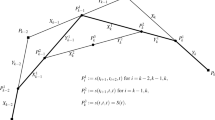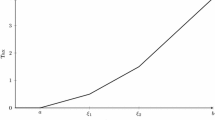Abstract
Variable degree polynomial (VDP) splines have recently proved themselves as a valuable tool in obtaining shape preserving approximations. However, some usual properties which one would expect of a spline space in order to be useful in geometric modeling, do not follow easily from their definition. This includes total positivity (TP) and variation diminishing, but also constructive algorithms based on knot insertion. We consider variable degree polynomial splines of order \(k\geqslant 2\) spanned by \(\{ 1,x,\ldots x^{k-3},(x-x_i)^{m_i-1},(x_{i+1}-x)^{n_i-1} \}\) on each subinterval \([x_i,x_{i+1}\rangle\subset [0,1]\), i = 0,1, ...l. Most of the paper deals with non-polynomial case m i ,n i ∈ [4, ∞ ), and polynomial splines known as VDP–splines are the special case when m i , n i are integers. We describe VDP–splines as being piecewisely spanned by a Canonical Complete Chebyshev system of functions whose measure vector is determined by positive rational functions p(x), q(x). These functions are such that variable degree splines belong piecewisely to the kernel of the differential operator \(\frac{d}{dx} p \frac{d}{dx} q \frac{d^{k-2}} {dx^{k-2}}\). Although the space of splines is not based on an Extended Chebyshev system, we argue that total positivity and variation diminishing still holds. Unlike the abstract results, constructive properties, like Marsden identity, recurrences for quasi-Bernstein polynomials and knot insertion algorithms may be more involved and we prove them only for VDP splines of orders 4 and 5.
Similar content being viewed by others
References
Bosner, T.: Knot Insertion Algorithms for Chebyshev Splines. Ph.D. thesis, Dept. of Mathematics, University of Zagreb. http://web.math.hr/~tinab/TinaBosnerPhD.pdf (2006). Accessed 8 February 2006
Bosner, T., Rogina, M.: Non-uniform exponential tension splines. Numer. Algorithms 46, 265–294 (2007)
Costantini, P.: Variable degree polynomial splines. In: Méhauté, A.L., Rabut, C., Schumaker, L.L. (eds.) Curves and Surfaces with Applications in CAGD, pp. 85–94. Vanderbilt University Press (1997)
Costantini, P.: Properties and applications of new polynomial spaces. Int. J. Wavelets Multiresolut. Inf. Process. 4(3), 489–507 (2006)
Costantini, P., Kaklis, P.D., Manni, C.: Polynomial cubic splines with tension properties. Comput. Aided Geom. Des. 27, 592–610 (2010)
Costantini, P., Lyche, T., Manni, C.: On a class of weak Tchebycheff systems. Numer. Math. 101, 333–354 (2005)
Costantini, P., Pelosi, F., Sampoli, M.: New spline spaces with generalized tension properties. BIT Numer. Math. 48, 665–688 (2008)
Goodman, T., Mazure, M.L.: Blossoming beyond extended Chebyshev spaces. J. Approx. Theory 109, 48–81 (2001)
Kaklis, P.D., Pandelis, D.G.: Convexity preserving polynomial splines of non-uniform degree. IMA J. Numer. Anal. 10, 223–234 (1990)
Koch, P.E., Lyche, T.: Construction of exponential tension B-splines of arbitrary order. In: Laurent, P.J., Le Méhauté, A., Schumaker, L.L. (eds.) Curves and Surfaces, pp. 255–258. Academic Press, Boston (1991)
Mazure, M.L.: Piecewise smooth spaces in duality: Application to blossoming. J. Approx. Theory 98, 316–353 (1999)
Mazure, M.L.: Quasi–Chebyshev splines with connection matrices: application to variable degree polynomial splines. Comput. Aided Geom. Des. 18, 287–298 (2001)
Mazure, M.L.: Blossoms and optimal bases. Adv. Comput. Math. 20, 177–203 (2004)
Mazure, M.L.: Blossoming stories. Numer. Algorithms 39, 257–288 (2005)
Mazure, M.L.: Towards existence of piecewise Chebyshevian B-spline bases. Numer. Algorithms 39, 399–414 (2005)
Mazure, M.L.: On a general new class of quasi-Chebyshevian splines. Numer. Algorithms 58(3), 399–438 (2011)
Mazure, M.L.: Quasi-extended Chebyshev spaces and weight functions. Numer. Math. 118, 79–108 (2011)
Rogina, M.: On construction of fourth order Chebyshev splines. Math. Commun. 4, 83–92 (1999)
Rogina, M., Bosner, T.: A de Boor type algorithm for tension splines. In: Cohen, A., Merrien, J.L., Schumaker, L.L. (eds.) Curve and Surface Fitting, pp. 343–352. Nashboro Press, Brentwood (2003)
Schumaker, L.L.: On Tchebycheffian spline functions. J. Approx. Theory 18, 278–303 (1976)
Schumaker, L.L.: Spline Functions: Basic Theory. John Wiley & Sons, New York (1981)
Author information
Authors and Affiliations
Corresponding author
Additional information
Communicated by L. L. Schumaker.
Rights and permissions
About this article
Cite this article
Bosner, T., Rogina, M. Variable degree polynomial splines are Chebyshev splines. Adv Comput Math 38, 383–400 (2013). https://doi.org/10.1007/s10444-011-9242-z
Received:
Accepted:
Published:
Issue Date:
DOI: https://doi.org/10.1007/s10444-011-9242-z




